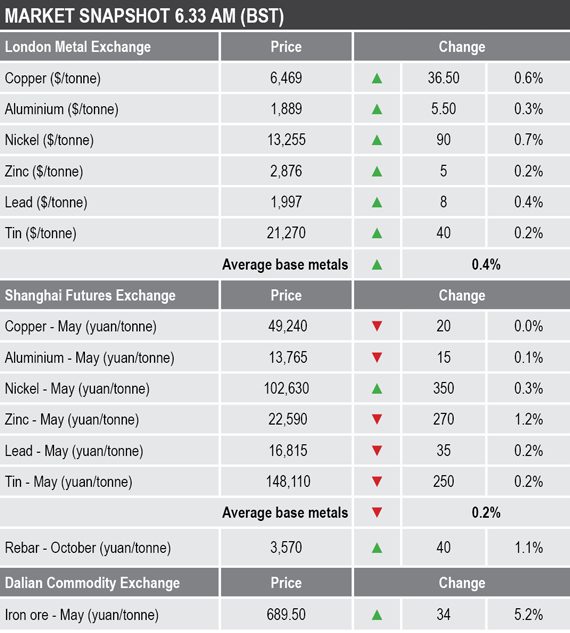Nickel once again led the way with a 0.7% rise on Wednesday, with the metal’s three-month price recently quoted at $13,255 per tonne, up from Tuesday’s close at $13,165 per tonne.
The three-month copper price was up by 0.6% at $6,469 per tonne, compared with Tuesday’s close at $6,432.50 per tonne, while the rest were up between 0.2% and 0.4%.
Volume was below average with 3,546 lots traded on LME Select as at 6.33 am London time. This compares with the 5,961 lots traded at a similar time on Tuesday.
The spot precious metals prices were all firmer this morning, led by platinum that is up by 1.3% at $860.20 per oz, compared with Tuesday’s close at $860 per oz. Silver was up by 0.5%, while palladium and gold were both up by 0.1%, with the latter recently quoted at $1,293.51 per oz, compared with $1,292.10 per oz at Tuesday’s close.
Despite base metals prices on the LME being higher on Wednesday, those on the Shanghai Futures Exchange were for the most part weaker. The exception was May nickel that was up by 0.3%, while the rest were down between little changed for May copper and 1.2% for May zinc. May copper was recently quoted at 49,240 yuan ($7,326) per tonne, compared with Tuesday’s close of 49,260 per tonne.
While most of the base metals prices in China have not seen follow-through buying after Monday’s better Chinese economic data, the steel-oriented metals have; the May iron ore contract on the Dalian Commodity Exchange was up by 5.2% at 689.50 per tonne, from 655.50 yuan per tonne at the close on Tuesday – marking the second consecutive day of strong gains.
On the SHFE, the October steel rebar contract was up by 1.1% at 3,570 yuan per tonne compared with 3,530 yuan per tonne at Tuesday’s close.
In wider markets, the spot Brent crude oil price has also been climbing; this morning it is up by 0.36% at $69.79 per barrel from $69.54 per barrel at the close on Tuesday.
The yield on US 10-year treasuries was firmer and recently quoted at 2.5103% againt 2.4792% at a similar time on Tuesday. The yields on the US 2-year and 5-year treasuries remain inverted – they were recently quoted at 2.3317% and 2.3224% respectively. The German 10-year bund yield was also firmer and was recently quoted at minus 0.0200% after minus 0.0300% at a similar time on Tuesday morning. The pick-up in the yields suggests a slightly more risk-on environment.
Asian equity markets were positive on Wednesday: the Nikkei (+0.97%), the CSI 300 (+0.30%), the Hang Seng (+0.87%), the Kospi (+1.17%) and the ASX 200 (+0.68%).
This follows a mixed performance in western markets on Tuesday: in the United States, the Dow Jones Industrial Average closed down by 0.3% at 26,179.13, and in Europe, the Euro Stoxx 50 was up by 0.3% at 3,395.70.
The dollar index has once again run into overhead supply above the 97.50 level, which has capped the upside around five to six times since November 2018. It was recently quoted at 97.16.
The weaker dollar, which has not been helped by Tuesday’s weak US durable goods orders, has supported most of the other major currencies: the euro (1.1221), sterling (1.3166) and the Australian dollar (0.7115) are all firmer, while the Japanese yen (111.52) that seems to be slightly weaker as the markets seem more risk-on is an exception.
The yuan remains rangebound but slightly firmer – it was recent quoted at 6.7075, compared with 6.7177 at a similar time on Tuesday. With optimism for a trade deal running high, we should expect a stronger yuan should a trade deal come about. Before the trade dispute kicked off last year, the yuan was trading around the 6.4000 level. The other emerging market currencies we follow are looking firmer, especially the Indian rupee.
Economic data already out on Wednesday shows China’s Caixin services purchasing managers index (PMI) rising to 54.4 from 51.1. Later there is services PMI data out across Europe and the US, plus data on EU retail sales, US employment change and US crude oil inventories. With China’s data showing some improvement while US data is starting to look weaker, it may well encourage the US to push on with a trade deal.
The metals are quite diverse, lead is struggling and prices are drifting, while zinc is trending higher. Tin, nickel and copper are oscillating sideways, but are holding up in high ground and aluminium is stuck in a sideways range, $100 per tonne above the start-of-year lows. So zinc, tin, nickel and copper seem well placed to extend gains on either a trade deal, or on further better economic data from China, and if that unfolds, lead and aluminium are likely to be dragged higher too.
The precious metals look tired, so any pick-up in the outlook for global growth on the back of a trade deal, could see investors roll out of havens and into more risky commodities.



